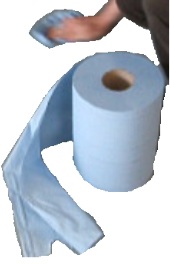Remove Spills to Control Slips (Trips and Falls)
- Deal with spills straight away
- Spills should be thoroughly cleaned and dried. A superficial effort that does not clean or dry the surface may create a greater risk than the original spill. "Mop-dry" floors can be very slippery
- Provide material to remove spills at identified high spill risk areas
- Use absorbent material to soak up the spill or possibly use a hand-held squeegee vacuum
- Paper towel is effective to clean up small spills
- Oily or greasy spills require detergent solution
- Consider using spill kits - they must be kept fully stocked
- Absorbent material must be removed as soon as it becomes saturated, and more absorbent material used - if needed
- Consider nominating one person each shift to be responsible for spills. (This will only work if that person is advised of any spills and is available to deal with spills immediately)

- This video (1 minute, 1 second) shows an animated slip on an oil spill with real-life video removing an oil spill
- Ensure slip-resistant footwear as needed
Dry-Cleaning Spills

A procedure to remove spills straight away by dry cleaning was present in the majority of healthcare (88%), wholesale, retail, etc (73%) and manufacturing (61%) workplaces. Such a procedure was not applicable in the majority of agriculture (72%), construction (58%) and mining & quarrying (54%) premises. This could be because these sectors include large external areas or wet-working areas.
Hand-held Squeegee Vacuums
Hand-held squeegee vacuums can be very effective in removing water spills.
These vacuums, sometimes called "window vacuums", may not be effective for larger spills, debris or viscous liquids (oil, grease, etc). The Authority commissioned research into the potential effectiveness of hand-held squeegee vacuums for spills. Hand-held squeegee vacuums should be operated, maintained and stored in accordance with the manufacturers instructions. The squeegee blades must be kept in good condition.
Research found that the hand-held squeegee vacuum
- can be very effective in removing spilt water and returning the floor to a low slip potential
- can dry floor surfaces much more quickly and effectively than a well wrung-out mop
- may be most effective in removing small spills of relatively clean non-viscous liquid (e.g. water)
- may be better at cleaning up water droplets than pools of water
- may not be intended to vacuum large amounts of liquid from horizontal surfaces
- may be blocked/ damaged by viscous liquids or debris

Spill risks are an important part of Slip Risk Assessment and Prevention
A risk assessment approach to Spills slips (trips and falls) can include the following steps
